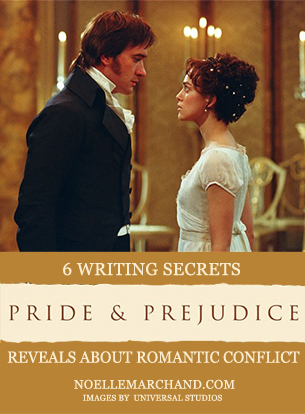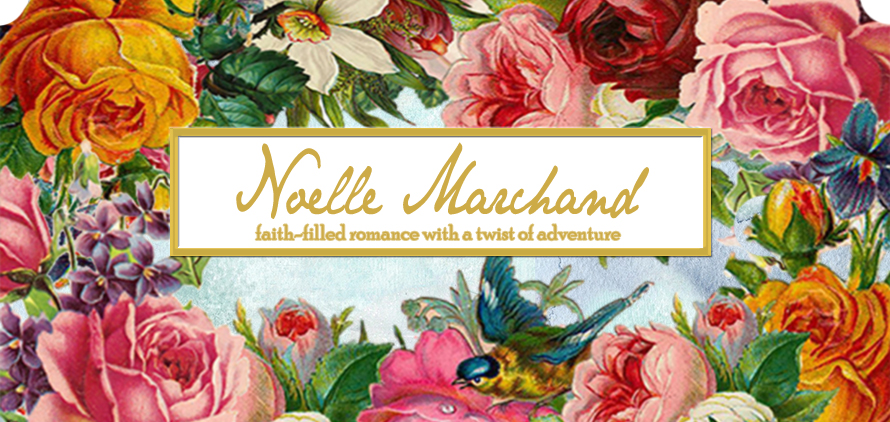
“It is a truth universally acknowledged, that a romance writer in pursuit of a good book, must be in want of strong romantic conflict.”
Jane Austen is the queen of writing romantic conflict. Case in point: we still laugh, cheer and groan at Elizabeth and Darcy’s verbal sparring more than two hundred years after Pride and Prejudice was first published. It’s impressive enough to make brothers, sons, husbands and fathers willing to sit through an adaptation of a romance novel set in Regency England with only a minimum amount of complaining. Yet, it somehow only adds to one of the most breath-taking love stories ever committed to pen, paper and movie screens. What is the secret behind Jane Austen’s success?
It certainly isn’t her name. When she first published Pride & Prejudice, she was still writing under the simple and mysterious pseudonym of “a Lady”. No, what made her books wildly popular is the very thing her clever dialogue was birthed from—outstanding romantic conflict. This is what pushes the hero and heroine apart while simultaneously pulling them together.
I have read Pride & Prejudice and watched the 1995 movie adaptation several times. I watched the shorter 2005 movie enough that I memorized the entirety of the dialogue. I even took a college course on it and Austen’s other books. It’s was an obsession, I admit. However, it’s one that I’m convinced helped me to write six published and successful novels with, if I may say so myself, strong romantic conflict. Here are the secrets about writing romantic conflict that I learned from one of my all-time favorite books and movies, Pride and Prejudice:
*Warning: This article contains spoilers for those who have not read Pride & Prejudice or seen the 2005 movie version. If you haven’t done either of those things, what is wrong with you? They are amazing! Go read or see it now! 😉
1. Base romantic conflict on something meaningful.
Elizabeth and Darcy do not fall into instant dislike. In fact, attraction and interest is obvious within the first few minutes of their acquaintance. What they do have are preconceived notions about each other based on their knowledge of the other person’s circumstances and station in life. They are also over confidence in their individual ability to determine the character of another person based on a small amount of evidence in a short amount of time. Hence, Pride & Prejudice.
Do you see the difference, though? Their dislike is not actually based on the other person’s behavior. Rather, they use the other person’s behavior to confirm their preconceived notions which, in turn, causes the dislike. It isn’t about the surface things like Darcy’s disinclination to dance or Elizabeth’s sharp tongue. It goes much deeper to Elizabeth and Darcy’s character, perceptions and ideals. That is where true, honest, legitimate and provocative romantic conflict is born—at the soul level of multi-dimensional characters.
2. Subtlety is key.
Once a romantic conflict has been established through a fully-formed character, it should naturally seep in that person’s thought, actions and dialogue. It can reveal itself in a variety of way. For Darcy and Elizabeth, it shows in their dialogue. Notice that Darcy and Elizabeth do not constantly bicker through-out the entire movie or book. On the surface, they are generally polite. There is, however, an underlying tension to their interactions. It’s an amalgamation of their attraction/interest and their romantic conflict.
It’s seen in their often thwarted avoidance of each other and their disparagement of the other person’s character (to others and not directly to each other). Occasionally and increasingly, it begins to bubble to the surface. This is where we get brilliant witticisms, teasing and pointed dialogue. We are able to enjoy it because we know the reason behind the behavior is deeply ingrained within their character so we view it as legitimate.
3. Reveal the ugly truth at the heart of the conflict.
Push your characters until they can no longer hide the truth from each other. This is where the gloves come off. Now, both characters understand and acknowledge what is keeping them apart. I know it can be scary to put everything out in the open, but it won’t weaken your conflict to do so. It will actually strengthen it. We see that, despite acknowledging the problem, there is no easy solution.
This plays out in Darcy’s proposal to Elizabeth. You can see that rather than inducing a moment of reconciliation, it sparks an airing of grievances that pits them even more against each other and pushes them farther apart. I love this scene from the 2005 version because it doesn’t end there. At the end, we see their attraction to each other is still there. The fact that it isn’t enough to overcome their differences once again makes the conflict between them seem all the stronger.
4. Growth and change must take place within the individual.
Remember how we built our romantic conflict at the character level? That exactly where we have to return to if we want to start resolving it. This is necessary at this point in the story because the happy ending needs to be believable. We aren’t going to disregard the conflict completely, but we are going to challenge it by allowing the characters to grow.
For Elizabeth, receiving Darcy’s letter about Mr. Wickham changes her perceptions of Darcy’s character. Her prejudice is beginning to fade. Meanwhile, Elizabeth’s refusal has shown Darcy the ugly truth about his pride. The next time we see him, there is a new humbleness to his person. It’s an aspect of his character he hasn’t shown Elizabeth, even though it was there all along.
5. Resolution should still seems impossible.
With our romantic conflict currently being dismantled, it’s important to add in more complications, adversity and obstacles. Now, even though our character may be willing to put their differences aside, something makes them unable to do so. This may be something internal, external or a combination of both. Whatever it is, the romantic conflict cannot be put to rest until the characters both individually and collectively overcome it.
To get to that point, everything that can go wrong should go wrong. Lydia’s elopement, news of Darcy’s engagement, a visit from Lady Catherine de Burg, even Jane’s engagement all add to the mayhem until the final, climatic moment.
6. Release the tension.
Have fun. These are the reader’s and writer’s last few moments with character they have grown to love. We want to see them happy. We want to have a glimpse of what their lives will be like going forward. This is what makes all of the drama worth it. In fact, my favorite part of the book is after Elizabeth accepts Darcy’s proposal. We get a glimpse of what their lives will be like as a married couple. I love it so much that I often try to include that same thing at the conclusion of my own books.
Hey, do you notice something? We practically figured out how to write an entire novel just by studying the romantic conflict. That’s because romantic conflict is what carries the story when it comes to romance. I hope this helped you gain insight on how to write it effectively. Or, if you’re a reader, showed you some of what goes into making a book a page-turner. Until next time…
Happy Reading!
Noelle Marchand
